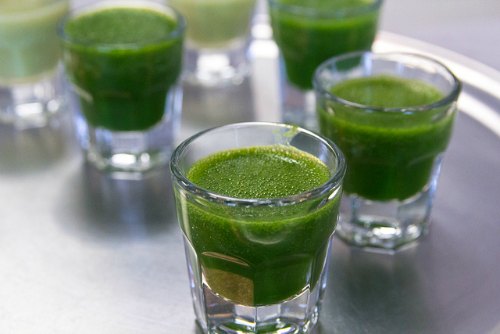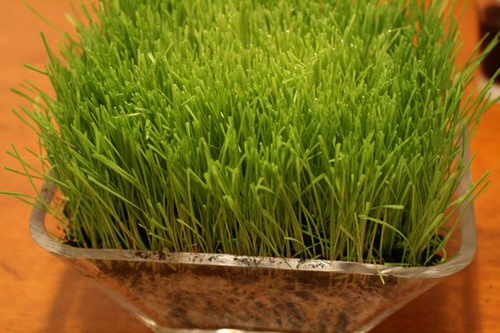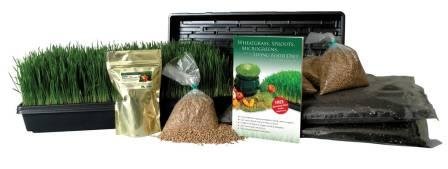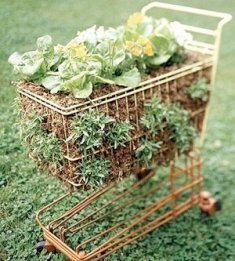Easy Tips on How to Grow Wheatgrass in Pots and Container Gardens
We'll teach you how to grow wheatgrass and to help you learn about the many health benefits of wheatgrass.
Popular at juice bars and smoothie shops, wheatgrass is a form of wheat, but it looks more like regular lawn grass. Since the 1940’s, wheatgrass has been touted as having numerous health benefits and is extremely easy to grow in a variety of settings.
What is Wheatgrass?
Wheatgrass is pretty much exactly how it sounds – the young grass sprouts of a plant related to the common wheat plant. It looks a lot like everyday lawn grass, but is thinner, slightly hollow, and can be turned into juice.
Health Benefits of Wheatgrass
A common health claim of wheatgrass is that it is substantially more potent than “regular” vegetables. While this claim is slightly exaggerated, the health benefits of wheatgrass are evident, as wheatgrass is full of important amino acids, fiber, beta carotene, and vitamins. Wheatgrass also has very high levels of chlorophyll, which is said to aid in body detoxification.
The health benefits of wheatgrass are wide ranging, though not fully proven. One small study showed that daily wheatgrass intake reduced the symptoms of ulcerative colitis. Another study showed that wheatgrass has a chelation effect, or the ability to remove heavy metals from the body.
Proponents of wheatgrass claim that it can rebuild healthy red blood cells, can improve blood-glucose levels in diabetic patients, and that it is a great for reducing bad breath and bodily odor.
Though related to the common wheat plant, it’s important to know that wheatgrass does not contain wheat gluten.
Most users drink about 2 ounces once or twice a day, though more can be taken if you can tolerate it. However, start with 2 ounces once a day to ensure you don’t have any negative reactions.
Wheatgrass smoothies are very popular. Image used under a Creative Commons license with the kind permission of Steven Depolo and Flickr
How to Grow Wheatgrass
Learning how to grow wheatgrass is virtually as easy as growing the grass on your lawn! You can either buy wheatgrass already grown at the grocery store and prune the tops and wait for new growth, or you can also use a wheatgrass kit or start your wheatgrass from seeds.
However, research has shown that the second growth (after the first pruning) has less nutritional value than the first harvest, so learning how to grow wheatgrass on your own is not only better for you, but also better for your wallet.
Wheatgrass kits are an easy and affordable way to get your fix. Image used under a Creative Commons license with the kind permission of thebittenword.com and Flickr
Wheatgrass Seeds
Growing wheatgrass from seed is easy to do but requires a little work. However, this method allows you to control every variable to ensure you’re getting the best wheatgrass possible.
Materials:
- Wheatgrass seeds, also called wheat berries
- Growing trays with lids
- Soil
- Good natural lighting or a grow light
Buy some wheatgrass seed and soak the seeds in water for 8 to 12 hours. After this, drain the water and wrap your seeds loosely in a paper towel. While you can skip this step and proceed straight to planting, this step aids in germination.
While waiting for germination, you can prepare your growing tray. Poke a few small holes in the bottom of the growing tray and in the lid. This will ensure water drains and improves airflow.
Next, prepare your soil mixture. Several mixes of soil will work, but a combination of potting soil, peat moss, compost, and a little vermiculite seems to work well.
Once a small white tail has sprouted from the seeds (if you decided to wait for germination), plant the seed on top of your soil. Place near a window that gets good natural light or under a grow light. If using a grow light, leave it on for 12 – 14 hours a day.
Wheatgrass seeds emerging from potting mix. Image used under a Creative Commons license with the kind permission of thebittenword.com and Flickr
During the first 2 – 3 days of growth, water once in the morning until the soil is very moist. Lightly mist your seed in the evening. Like grass seed, wheatgrass thrives in moist soil. Keep the lid on during this time.
After the third day, you can remove the lid. By now, plenty of wheatgrass shoots should be popping up and growing tall. You can also use a mild liquid fertilizer at this time.
Wheatgrass is susceptible to mold, especially if air isn’t circulating. You can increase your air circulation with a fan or air conditioning, but use occasionally a few times a day.
After 7 – 12 days, the wheatgrass should be tall enough for harvest – usually 7 – 8 inches tall. Of course you can let it grow taller, but eventually, the grass will begin to split and attempt to grow buds.
Cut your wheatgrass just above the soil. For optimal nutrition, juice right away. If you have leftovers, wheatgrass can be stored in a container in your refrigerator for about a week. If you notice the grass turning yellow, you may have waited too long.
How to harvest wheatgrass from your container garden. Image used under a Creative Commons license with the kind permission of Kristoffer Trolle and Flickr
Wheatgrass Kits
Perhaps the easiest way to grow wheatgrass is by using a wheatgrass kit. A wheatgrass kit contains everything you need to get started and reduces the mystery about how to grow wheatgrass.
Most wheatgrass kits include seeds, a growing tray, soil, and perhaps a fertilizer (or azomite). Many kits are certified USDA Organic to guarantee that you are getting the healthiest wheatgrass possible.
Once you have your kit, the process is basically the same as outlined previously for growing wheatgrass from seed.
If you need a recommendation, then this is the best wheatgrass kit on Amazon.com. It's amazing! Everything you need in one box.
Go from How to Grow Wheatgrass to the Container Vegetable Gardening menu
Learn more tips and tricks for Successful Container Gardening








